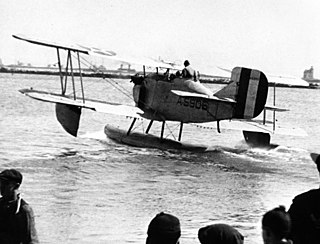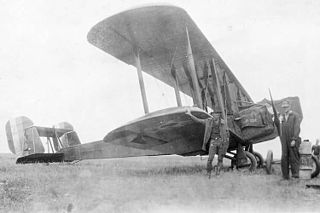
The ERCO Ercoupe is an American low-wing monoplane aircraft that was first flown in 1937. It was originally manufactured by the Engineering and Research Corporation (ERCO) shortly before World War II; several other manufacturers continued its production after the war. The final model, the Mooney M-10, first flew in 1968 and the last model year was 1970. It was designed to be the safest fixed-wing aircraft that aerospace engineering could provide at the time, and the type continues to enjoy a faithful following.

The BAT F.K.23 Bantam was a British single-seat fighter biplane produced by British Aerial Transport Company Limited of London during World War I.

The Kinner C-7 Envoy was an American four-seat cabin monoplane built by Kinner Airplane & Motor Corporation in the 1930s.

The Elias EM was a 1920s American general-purpose and marine expeditionary biplane built by Elias.

The Curtiss Eagle was an airliner produced in small numbers in the United States shortly after World War I. The aircraft was a conventional biplane with three-bay, unstaggered wings of equal span. The fuselage was a very advanced design for its day, incorporating careful streamlining of its monocoque structure, and offering the crew as well as the passengers a fully enclosed cabin. The Eagle is sometimes named as the first American tri-motor aircraft; however Curtiss' own Model H flying boat flew with three engines for a time in 1914 before being converted back to twin-engine configuration.

The Curtiss Model R was a utility aircraft produced for the United States Army and Navy during World War I. It was a conventional, two-bay biplane with slightly staggered wings of unequal span. The aircraft was provided with two open cockpits in tandem and fixed tailskid undercarriage, but many were built for the Navy with twin floats replacing the wheels. During the course of the war, Model Rs were used for general liaison and communication duties, as well for observation, training, and as air ambulances. In practice, the Curtiss powerplants supplied with these aircraft proved insufficient and were mostly replaced with Liberty engines. The Navy's Model R-3 floatplane had extended-span, three-bay wings, and was intended for use as a torpedo bomber. Some of these were later fitted with wheeled undercarriage and transferred to the Army as bombers under the designation Model R-9.

The Keystone LB-6 and LB-7 were 1920s American light bombers, built by the Keystone Aircraft company for the United States Army Air Corps, called Panther by the company, but adoption of the name was rejected by the U.S. Army.

The Great Lakes BG was an American carrier-based dive bomber of the 1930s. Designed and built by the Great Lakes Aircraft Company of Cleveland, Ohio, 61 were used by the United States Navy and United States Marine Corps from 1934 to 1940.

The Boeing AT-15 was an American twin-engined bomber crew trainer designed and built by Boeing's Wichita Division. Only two prototypes, designated XAT-15, were built. Plans to build over 1,000 were cancelled on the United States' entry into the Second World War.

The Keystone LB-5 was a bomber aircraft produced in the United States in the late 1920s. Its manufacturer nicknamed it the Pirate, but this name was not officially adopted by the United States Army Air Corps (USAAC).

The Beecraft Queen Bee was an American V-tailed four-seat cabin monoplane, designed and built by Bee Aviation Associates (Beecraft).
The Security Airster S-1 is an American two-seat single-engined monoplane designed by Bert Kinner and built by his Security National Aircraft Corporation later named the American Aircraft Corporation.

The Mohawk M1C was a 1920s American two or three-seat low-wing monoplane designed and built by Mohawk Aero Corporation of Minneapolis, Minnesota. One M1C was evaluated by the United States Army Air Corps in 1930 as the YPT-7 Pinto for use as a primary trainer.

The Stearman XBT-17 was a prototype 1940s American two-seat low-wing monoplane primary trainer designed and built by Stearman Aircraft. It was evaluated by the United States Army Air Force in 1942 as the XBT-17.

The North American NA-40 was an American prototype bomber aircraft developed by North American Aviation in the late 1930s for evaluation by the United States Army Air Corps. Although unsuccessful, it led directly to the North American B-25 Mitchell medium bomber.

The Elias XNBS-3 was a 1920s prototype biplane bomber built by Elias for the United States Army Air Corps.

The Spartan 8W Zeus was a prototype military aircraft trainer built by Spartan Aircraft Company in the United States in 1937. It was based on the airframe of the Spartan Executive civil aircraft. The sole airframe produced was designated serial number 8W-1 and was registered as NX17612

The Elias EC-1 Aircoupe was an American two-seat parasol wing monoplane designed and built by Elias of Buffalo, New York.

The Curtiss Model 36 XNBS-4 was a 1920s prototype biplane night bomber built by the Curtiss Aeroplane and Motor Company for the United States Army Air Corps.

The L-W-F Model H Owl was a large American twin-boom trimotor biplane designed and built by LWF Engineering as a mail plane in 1920, but after being rejected for that role, the single prototype was sold to the United States Army Air Service for evaluation as a bomber but failed to secure any orders.

























